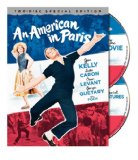| Reviews & Columns |
|
Reviews DVD TV on DVD Blu-ray 4K UHD International DVDs In Theaters Reviews by Studio Video Games Features Collector Series DVDs Easter Egg Database Interviews DVD Talk Radio Feature Articles Columns Anime Talk DVD Savant Horror DVDs The M.O.D. Squad Art House HD Talk Silent DVD
|
DVD Talk Forum |
|
|
| Resources |
|
DVD Price Search Customer Service #'s RCE Info Links |
|
Columns
|
|
|
American in Paris: Two-Disc Special Edition, An
THE MOVIE:
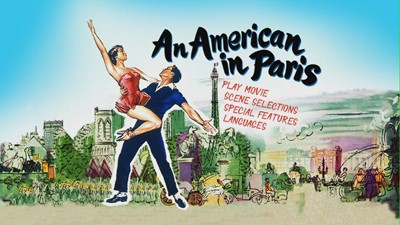
An American in Paris is the movie that finally forced me to admit that I really did like musicals. Adolescent stubbornness had made me declare that all musicals were corny, and as a genre, I had no time for them. Even then, though, I had a few that I would insist were merely the exceptions to prove the rule. That changed when I saw some movie program or other, the source of which is now lost in my memory, that showcased the 18-minute-plus ballet sequence that closed the 1951 Gene Kelly vehicle. The commentators praised the guts that Kelly and director Vincente Minnelli displayed in asking their audience to watch a full dance sequence, with no dialogue or sung lyrics, based around a Gershwin orchestral piece. I was sufficiently intrigued to check the movie out, and An American in Paris forever changed how I viewed movie musicals.
As legend has it, George Gershwin's "An American in Paris" suite was the sole impetus for doing this movie. With the song and its title in hand, producer Arthur Freed went off to create a picture about an American artist living in post-War France, working in as many of the Gershwins' famous catalogue in as he could. One of the requests the songwriting duo made when setting up the deal for the adaptation was that "An American in Paris" remain intact and played in full, and this fit perfectly with the already in-place plan to include an extended dance sequence in the movie. Reportedly, Gene Kelly used the Powell & Pressburger film The Red Shoes to convince MGM that it could be done, and once everyone had signed off, a classic was born.
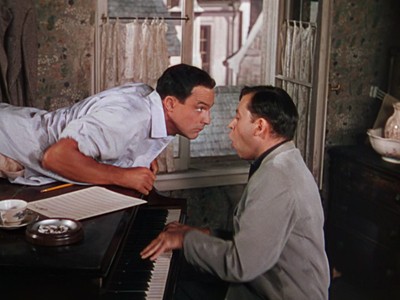
In An American in Paris, Kelly plays Jerry Mulligan, a veteran who stayed in France after the war to pursue a career in painting. Living in a Bohemian quarter of Paris, he is friends with other ex-patriots, including the jazz pianist Adam Cook (Oscar Levant). Adam provides Jerry with a comedic sidekick, as well as an added reason to launch into the occasional song-and-dance routine. Not that Jerry needs such a concrete reason to burst into song. Any everyday event will do. In one of the most memorable sequences of the film, he decides to turn an English lesson he's giving the neighborhood kids into a lesson in George and Ira's "I've Got Rhythm." The children chant the "I Gots," and Gene does the rest.
On a broke afternoon, Jerry takes some of his canvases to the open market to try to drum up some cash. There he meets Milo (Nina Foch), a wealthy American divorcee who takes a shine to his paintings and to their painter. She becomes Jerry's patron, though she has a little more than art on her mind. The pair agrees to disagree on the subject of romance, which doesn't mean that when Jerry becomes enchanted by tres jolie ingénue Lise (Leslie Caron), it doesn't cause trouble. Not only is Milo jealous, but Adam's friend, the French singer Henri Baurel (Georges Guetary), would have cause to be jealous, as well, if he knew what was going on. Lise is his girl. Cue the collision of dueling love triangles!
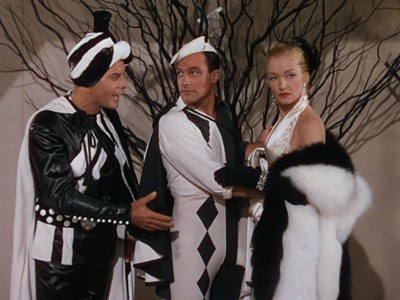
An American in Paris is at times a big, sappy romance, as well as a silly comedy trading on old vaudeville routines and Gene Kelly's rubber limbs. The story is as thin as the odor eater's in the stars' tap shoes, but it matters little. Vincente Minnelli keeps the pace moving, never taking too long between songs, giving us a variety of Gershwin numbers in a variety of tempos and styles. We get the slow and romantic "Our Love is Here to Say" when Jerry is serenading Lise along the Seine, as well as the peppy "Tra-La-La (This Time is Really Love)," with Jerry mugging alongside Adam while straddling his piano. Also quite funny is Oscar Levant's solo scene, playing every member of the orchestra in a daydream where he performs a Gershwin concerto to an enthusiastic crowd of people who aren't just like him, but are him. (Yep, he plays the audience, too!) The all-around tone of the film is jaunty, with gorgeous sets and likable actors strutting their stuff without a whiff of self-consciousness. Declaring that they don't make them like An American in Paris anymore wouldn't be a cliché, it's a simple fact.
And, of course, even if the first 94 minutes of the movie are two syrupy for your tastes, you can still appreciate the audacious artistry of the "An American in Paris Ballet." In an explosion of color and energy, Kelly recreates the entire movie as a ballet that plays out in his character's mind. Believing he has lost Lise to Henri, Jerry mulls over his short time with the girl, seeing Paris as a city alive with dance, and his romantic quarry as an uncatchable sprite leaping through its streets. It's as much a celebration of being in love with the city as it is a celebration of being in love with the girl. In fact, the whole movie is about being in love with the art, the food, and the freedom to live life according to one's passions. In the ballet, we see abstract representations of things that have made Paris great, from its personalities and architecture to sets and costumes that mirror the styles of famous French painters, including Kelly jumping into a Tolouse-Lautrec painting (Chocolat) and bringing it to life. It's a glorious summation of what preceded it, while also gently paving the way for the ending Jerry couldn't dare dream of.
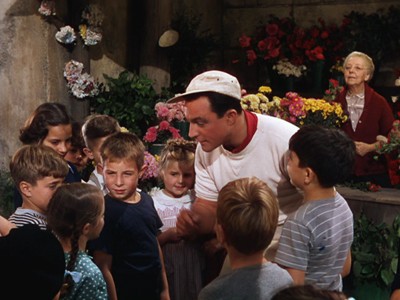
THE DVD
Video:
An American in Paris first came to DVD in 1999, released as a fine single-disc edition that had no extras, but that looked reasonably good. This 2008 Two-Disc Special Edition boasts a "New Ultra-Resolution Digital Transfer," and the surface look of it is excellent. The restoration clean-up has removed any scratches or dirt, and the image is clean throughout. I didn't see any pixilation, and the colors look great, as do the blacks.
Comparisons to the original release show some slight differences in color choices, and there may be some debate as to which people prefer. Eyeballing a couple of scenes, we can see that the older disc was much brighter with a color palette that ran much hotter. I think careful study of my screengrabs show, though, that the new transfer has a more natural looking color palette that allows for greater detail, particularly in the darker facets of the picture.
I got my screengrabs as close as possible to matching frames. Given the swiftness of the dancing, and the fact that the time codes on the 2008 and 1999 discs are slightly different, it was a matter of eyeballing when to hit the trigger, so they aren't exact.
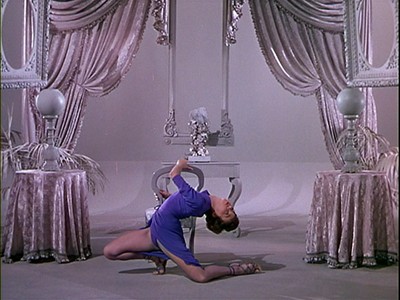
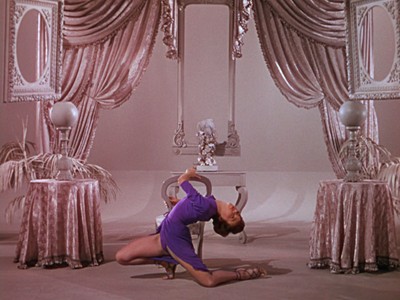
1999 vs. 2008
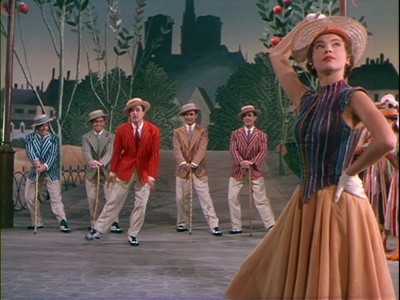
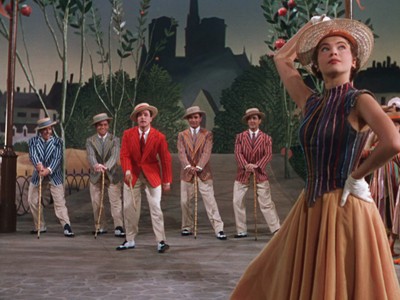
1999 vs. 2008
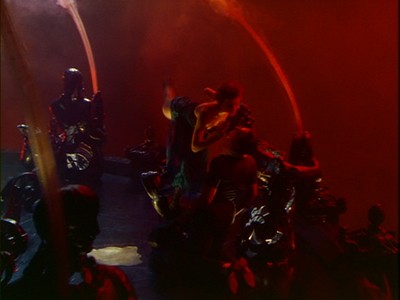
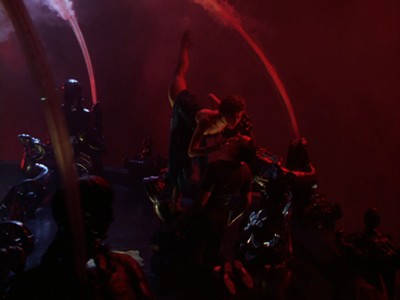
1999 vs. 2008
I prefer the newer disc. You can particularly see how much more nuanced the image quality is in the last shot, with all the bright reds overtaking the detailing in the original release. Likewise, in the first capture, the purple from 1999 looks oversaturated in comparison to the newer transfer. I could see such judgments being debatable, since, well...they always are.
Sound:
The audio aspect of the 2008 Two-Disc Special Edition is the same as the old disc: two options, English and French, in Dolby mono. The original English is a solid audio track, with good balance between dialogue and music.
Subtitles include English Closed Captioning, French, Japanese, and Thai. The Japanese and Thai are also included on the bonus features on DVD 2.
Extras:
The new 2-disc An American in Paris comes in a standard plastic case with a hinged tray on the interior. A thin slipcover with the same design as the cover sheet also comes with it. There are no inserts inside the case. The packaging is a vast improvement over the old cardboard snapper.
DVD 1 has four supplemental features, including the theatrical trailer, the only extra that appeared on the 1999 disc. In addition to this are two MGM shorts: the live-action FitzPatrick Traveltalks: Paris on Parade, a travelogue that spends just under 9 minutes revisiting a 1937 exhibition in the city, and a Tex Avery-directed cartoon, Symphony in Slang. Neither of these have had any clean-up done on their prints and do show their age.
A full-length audio commentary is a collage of vintage interviews put together by Patricia Ward Kelly, Gene Kelly's widow and an author in her own right. It includes snippets from Gene Kelly, Vincente Minnelli, producer Arthur Freed, screenwriter Arthur Jay Lerner, musical directors Johnny Green and Saul Chaplin, costume designer Irene Sharaff, art director Preston Ames, and performer/Gershwin expert Michael Feinstein. There are also excerpts from new interviews with actresses Leslie Caron and Nina Foch. Put together, these pieces give a detailed tour of the movie, covering every aspect of the lush production. Some of the old audio is a little staticky, but the overall quality of the information is worth it.
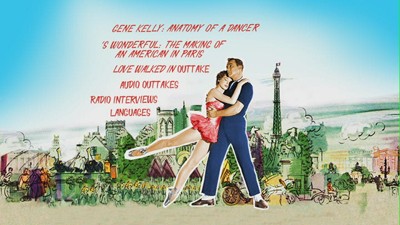
DVD 2 has a variety of new material, including a new documentary and rare outtakes from the production. One documentary, the 85-minute Gene Kelly: Anatomy of a Dancer, is a quality entry from the American Masters series, and it has previously been available on DVD on its own, as well as sitting alongside the 1999 Paris disc in the Gene Kelly Signature Collection. This was a biography piece worth owning on its own, so it's a very welcome inclusion here.
The new documentary is 'S Wonderful: The Making of an American in Paris, and it runs just over 42 minutes, using archival news footage, production materials (including behind-the-scenes photos and plans for set designs), and new interviews with Ward Kelly, Caron, Foch, two of the kids from the "I Got Rhythm" sequence (they were all offspring of French immigrants), a trumpet player from the orchestra, a dancer in the ballet, and a variety of scholars and biographers. Chaplin and Minnelli appear in old interviews, as well. This is a from-the-ground-up documentary, taking us from the inception of the piece through the casting and various challenges. There are anecdotes about Kelly's dedication to craft, conflicts with censors, and other aspects of the innovative production.
One deleted scene has surfaced, the song "Love Walked In," featuring Georges Guetary serenading Leslie Caron in the café, accompanied by Oscar Levant on piano. There are also seven audio outtakes, running in total just under 14 minutes. These feature alternate versions of songs in the film and numbers that were cut like Guetary singing "But Not For Me," Levant's piano solo for the same, and Gene Kelly's excised performance of "I've Got a Crush on You." Finally, there are 13 minutes of vintage radio interviews in three parts: Johnny Green alone, Gene Kelly alone, and Gene Kelly and Leslie Caron together.
FINAL THOUGHTS:
Highly Recommended. Oh, sooooo highly recommended. An American in Paris busted the musical genre to pieces and then built it back up, redefining what people believed could be done on a silver screen. Gene Kelly dances and sings in front of impressionistic sets of Paris, giving new life to familiar George and Ira Gershwin tunes while romancing Leslie Caron and making it look smooth and easy all the way through. It's a terribly entertaining film, but also challenging, breaking from traditional movie narrative styles to close the picture with an 18-minute ballet that is astounding. This new An American in Paris: Two-Disc Special Edition is packed with extras that take the viewer back in time to see how the whole shebang came together. Count your pennies and get ready to take another dip in this pool!
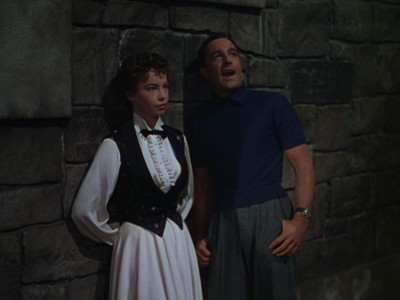 jerry
jerry
Jamie S. Rich is a novelist and comic book writer. He is best known for his collaborations with Joelle Jones, including the hardboiled crime comic book You Have Killed Me, the challenging romance 12 Reasons Why I Love Her, and the 2007 prose novel Have You Seen the Horizon Lately?, for which Jones did the cover. All three were published by Oni Press. His most recent projects include the futuristic romance A Boy and a Girl with Natalie Nourigat; Archer Coe and the Thousand Natural Shocks, a loopy crime tale drawn by Dan Christensen; and the horror miniseries Madame Frankenstein, a collaboration with Megan Levens. Follow Rich's blog at Confessions123.com.
|
| Popular Reviews |
| Sponsored Links |
|
|
| Sponsored Links |
|
|
| Release List | Reviews | Shop | Newsletter | Forum | DVD Giveaways | Blu-Ray | Advertise |
|
Copyright 2024 DVDTalk.com All Rights Reserved. Legal Info, Privacy Policy, Terms of Use,
Manage Preferences,
Your Privacy Choices | |||||||









